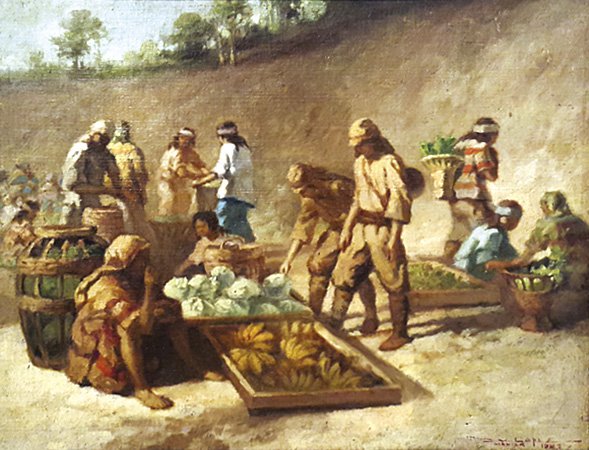Cultural Center of the Philippines
ENCYCLOPEDIA OF
PHILIPPINE ART
Baguio Market
1943 / Oil on canvas / 33 x 40 cm / Artist: Crispin V. Lopez / Jorge B. Vargas Museum collection / University of the Philippines Diliman
Crispin V. Lopez (1903-85) was an accomplished portrait painter whose detailed studies of faces were highly realistic. His portrait paintings vividly captured every crease and line on the face of his figures. During the Japanese occupation, Lopez did a number of figure paintings representing different ethnic groups, which conformed with the Japanese program of returning to traditional and indigenous forms. In contrast, his landscape paintings were sedate and genteel and lacked the forcefulness and conviction of his portrait paintings.
Baguio Market was painted in 1943 and depicted Japanese soldiers in their iconic baggy pants, heavy boots, and field caps with neck flaps. Japanese soldiers were rarely portrayed in paintings of this period although Fernando Amorsolo was said to have done a number of sketches of this subject. During the occupation, the Japanese set up a garrison at Camp John Hay in Baguio. Toward the end of the war in 1945, Gen Tomoyuki Yamashita transferred his headquarters to Baguio to escape the advancing American forces. It was also in Baguio where Yamashita signed the unconditional surrender of the Japanese army in 1945. As a result of the city’s strategic role, it suffered significant damage toward the end of the war in the battle for the liberation of Baguio.
In Baguio Market, Lopez chose to depict an everyday scene where, seemingly under a condition of normalcy, Japanese soldiers are seen milling around casually with the locals. The composition draws the eye to the foreground where two Japanese soldiers are standing in front of a vendor. One of the soldiers stoops over to examine some vegetables while the other one looks on. Are the soldiers buying condiments for their daily meal or are they inspecting the goods? Their motive is not clear since the faces of the figures are hazily portrayed, devoid of emotional content. The predominantly somber tones of brown and ochre are not foreboding and do not express the tension of the period. This work represents paintings done during the Japanese occupation, which may be classified as anecdotal.
Written by Helen Yu-Rivera
